

Britain in the Middle Ages. Denrenemiddelalder.dk. Med bulder og brag Anvendelsen af ildvåben starter dokumenteret i Kina 1132, men har også en helt tidlig forbindelse med Indien og den Arabiske verden.
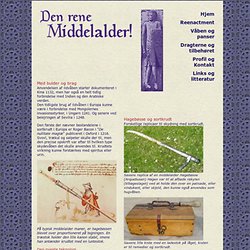
Den tidligste brug af ildvåben i Europa kunne være i forbindelse med Mongolernes invasionsstyrker, i Ungarn 1241. Og senere ved belejringen af Sevilia i 1248. Den første der nævner bestandelene i sortkrudt i Europa er Roger Bacon i "De nullitate magiæ" publiceret i Oxford i 1216. Svovl, trækul og salpeter skulle der til, men den precise opskrift var efter til hvilken type skydevåben det skulle anvendes til.
På typisk middelalder maner, er hagebøssen blevet over proportioneret på tegningen. Den nyeste teknologi Igennem middelalderen var bue og pil, samt bliider (katapulter) de gængse våben når man ville ramme nogen på lang distance. Håndskydevåben var tunge og tidskrævende at lade og ikke altid med den store træfsikkerhed, til gengæld skræmte lyden både fjendens Heste og Mænd under slaget. Ildrøret er den første primitive form. Life During the Middle Ages. Life During the Middle Ages Daily life during the Middle Ages is sometimes hard to fathom.
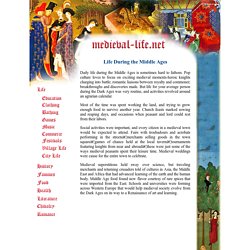
Pop culture loves to focus on exciting medieval moments-heroic knights charging into battle; romantic liaisons between royalty and commoner; breakthroughs and discoveries made. But life for your average person during the Dark Ages was very routine, and activities revolved around an agrarian calendar. Most of the time was spent working the land, and trying to grow enough food to survive another year. Church feasts marked sowing and reaping days, and occasions when peasant and lord could rest from their labors.
Social activities were important, and every citizen in a medieval town would be expected to attend. Medieval superstitions held sway over science, but traveling merchants and returning crusaders told of cultures in Asia, the Middle East and Africa that had advanced learning of the earth and the human body. Mythical Plants of the Middle Ages. GODE COOKERY SEARCHLooking for something specific at Gode Cookery?
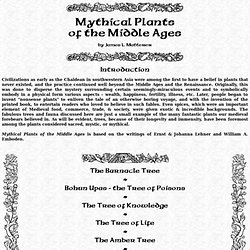
Search Gode Cookery courtesy of Master.com Please visit: The Gode Cookery Bookshop Medieval Cookery Books for sale at the Bookshop! EyeWitness To The Middle Ages and Renaissance. Life in a Christian Monastery, ca. 585"When he was dead his body was not placed with the bodies of the brethren, but a grave was dug in the dung pit, and his body was flung down into it. . .

" Crime and punishment in a medieval monastery: the monastery's Abbott provides insight into the monastic life. The Vikings Discover America, ca. 1000"There was no want of salmon either in the river or in the lake. " Five hundred years before Columbus, the Vikings discover a New World. Invasion of England, 1066The Norman conquest of Anglo-Saxon England described through the images of the 900 year-old Bayeux Tapestry. Anarchy in 12th Century EnglandThe Anglo-Saxon Chronicle paints a sobering picture of life in 12th century England that contrasts strikingly with Hollywood's image of the Middle Ages. Medieval Courtly Love. Facts and interesting information about the life and times of theMedieval Knights of England - Medieval Courtly Love Medieval Courtly LoveThe romance of Medieval Courtly Love practised during the Medieval times of the Middle Ages was combined with the Code of Chivalry and the art of Chivalry.
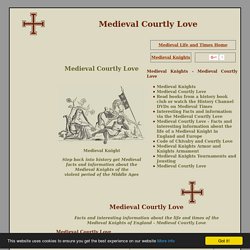
There were strict rules of courtly love and the art of Medieval Courtly Love was practised by the members of the courts across Europe during the Medieval times and era. The romance, rules and art of Medieval Courtly Love allowed knights and ladies to show their admiration regardless of their marital state. Middle Ages Women. Women of the Middle Ages: Scholars, Mistresses and Leaders The Middles Ages was a violent period dominated by men and wars.
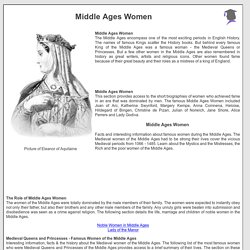
The names of the famous women of the Middles Ages have found their place in history as scholars, artists, through their religion or in their roles as the mistresses of great men. There are facts and short biographies of Joan of Arc, Jane Shore, Alice Perrers Katherine Swynford, Margery Kempe, Anna Comnena, Christine de Pizan, Heloise, Hildegard of Bingen, Julian of Norwich and Lady Godiva. Daily Life of a Noblewoman in the Middle Ages. Interesting facts and information about life and the lives of men and women in theMedieval period of the Middle Ages Daily Life of a Noblewoman in the Middle AgesThe daily life of a Noblewoman in the Middle ages followed a similar schedule to that of her lord.
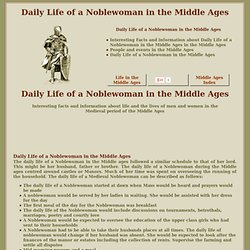
This might be her husband, father or brother.